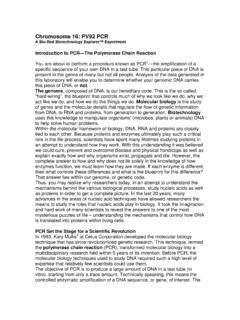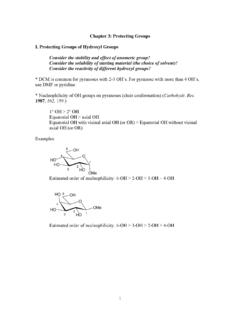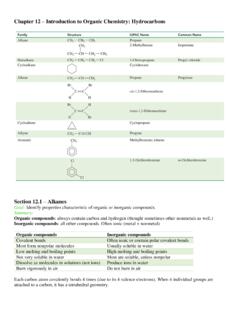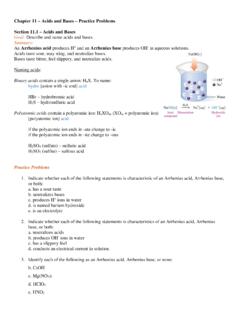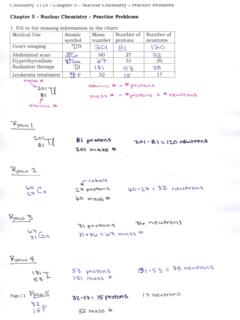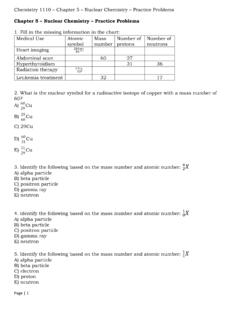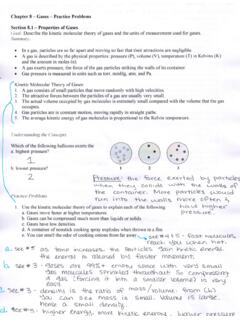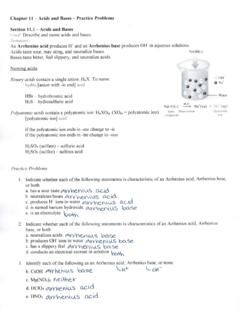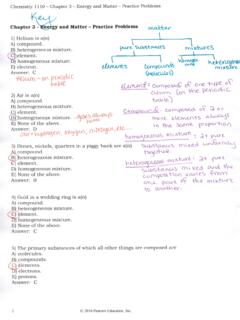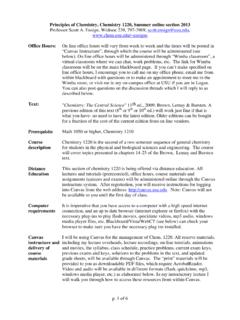Transcription of The Central Science 9th Edition - Chemistry Department
1 1 Prentice Hall 2003 Chapter 9 Chapter 9 Chapter 9 Molecular Geometry and Molecular Geometry and Bonding TheoriesBonding TheoriesCHEMISTRYThe Central Science 9th EditionDr. Doug Harris Prentice Hall 2003 Chapter 9 Lewis structures give atomic connectivity: they tell us which atoms are physically connected to which. The shape of a molecule is determined by its bond angles. Consider CCl4: experimentally we find all Cl-C-Cl bond angles are . Therefore, the molecule cannot be planar. All Cl atoms are located at the vertices of a tetrahedron with the C at its ShapesMolecular Shapes Prentice Hall 2003 Chapter 9 Molecular ShapesMolecular ShapesFigure Prentice Hall 2003 Chapter 9 In order to predict molecular shape, we assume the valence electrons repel each other.
2 Therefore, the molecule adopts whichever 3D geometry minimized this repulsion. We call this process ValenceShellElectronPair Repulsion (VSEPR) theory. There are simple shapes for AB2and ShapesMolecular Shapes 2 Figure Prentice Hall 2003 Chapter 9 There are five fundamental geometries for molecular shape:Molecular ShapesMolecular ShapesFigure Prentice Hall 2003 Chapter 9 When considering the geometry about the Central atom, we consider all electrons (lone pairs and bonding pairs). When naming the molecular geometry, we focus only on the positions of the ShapesMolecular ShapesFigure Prentice Hall 2003 Chapter 9 To determine the shape of a molecule, we distinguish between lone pairs (or non-bonding pairs, those not in a bond) of electrons and bonding pairs (those found between two atoms).
3 We define the electron domain geometry by the positions in 3D space of ALLelectron pairs (bonding or non-bonding). The electrons adopt an arrangement in space to minimize e -e ModelVSEPR Model 3 Prentice Hall 2003 Chapter 9 To determine the electron pair geometry: draw the Lewis structure, count the total number of electron pairs around the Central atom, arrange the electron pairs in one of the above geometries to minimize e -e repulsion, and count multiple bonds as one bonding ModelVSEPR ModelFigure VSEPR VSEPR ModelModel 4 Prentice Hall 2003 Chapter 9 The Effect of Nonbonding Electrons and Multiple Bonds on Bond Angles We determine the electron pair geometry only looking at electrons. We name the molecular geometry by the positions of atoms.
4 We ignore lone pairs in the molecular geometry. All the atoms that obey the octet rule have tetrahedral electron pair ModelVSEPR Model Prentice Hall 2003 Chapter 9 The Effect of Nonbonding Electrons and Multiple Bonds on Bond Angles By experiment, the H-X-H bond angle decreases on moving from C to N to O: Since electrons in a bond are attracted by two nuclei, they do not repel as much as lone pairs. Therefore, the bond angle decreases as the number of lone pairs ModelVSEPR Prentice Hall 2003 Chapter 9 The Effect of Nonbonding Electrons and Multiple Bonds on Bond AnglesVSEPR ModelVSEPR ModelFigure Prentice Hall 2003 Chapter 9 The Effect of Nonbonding Electrons and Multiple Bonds on Bond Angles Similarly, electrons in multiple bonds repel more than electrons in single ModelVSEPR 5 Prentice Hall 2003 Chapter 9 Molecules with Expanded Valence Shells Atoms that have expanded octets have AB5(trigonal bipyramidal) or AB6(octahedral) electron pair geometries.
5 For trigonal bipyramidal structures there is a plane containing three electrons pairs. The fourth and fifth electron pairs are located above and below this plane. For octahedral structures, there is a plane containing four electron pairs. Similarly, the fifth and sixth electron pairs are located above and below this ModelVSEPR Model Prentice Hall 2003 Chapter 9 Molecules with Expanded Valence Shells To minimize e e repulsion, lone pairs are always placed in equatorial ModelVSEPR ModelFigure 6 Prentice Hall 2003 Chapter 9 Molecules with Expanded Valence ShellsVSEPR ModelVSEPR ModelFigure Prentice Hall 2003 Chapter 9 Shapes of Larger Molecules In acetic acid, CH3 COOH, there are three Central atoms. We assign the geometry about each Central atom ModelVSEPR ModelFigure Prentice Hall 2003 Chapter 9 VSEPR ModelVSEPR Model
